Winter is truly underway with many of us experiencing our first splatter of snow this week.
Dog walks are one of the greatest things and in winter they can be extra beautiful.
But this weather can produce problems for our furry friends.That’s why we’ve put together this post for you…
To help you with our top tips, tricks and advice for what to do when the temperature gage drops below zero…
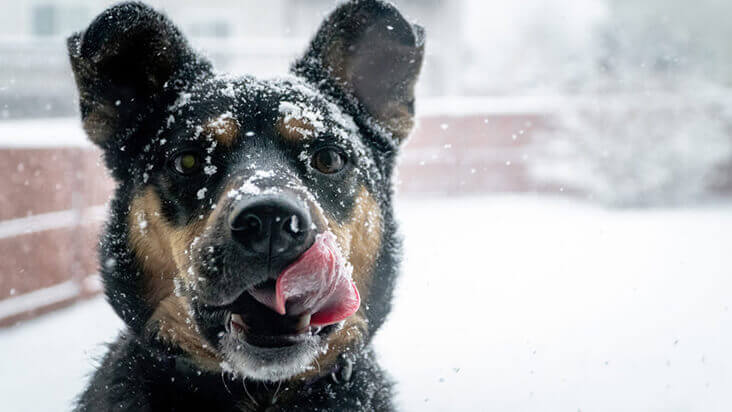
Keeping Your Dog Warm In Cold Weather
Just because your dog has a natural fur coat doesn’t mean that you should be the only one layering up in the cold weather…
That’s why the first and most simple change is to let your dog’s winter coat grow.. The extra fur will really helps when the temperature drops. Even if your dog spends most of the time inside.
Second, adding extra blankets to their bed or crate is also a good idea. And at night you might want to make sure their bed is in a warm spot in the house.
And finally, if your dog usually sleeps in an outdoor kennel, it’s a good idea to bring them inside the house in the coldest parts of winter.
Most dogs grow a thicker winter coat for this time of year. But if you have a short haired dog, or an older dog or puppy they may benefit from you getting them a winter coat.
Winter coats for dogs come in all shapes, sizes and colours. You may be wondering where to start looking.
It’s first important to do your research. Each dog will benefit from a different coat, so keep their needs in mind and read reviews from other dog owners. Even between breeds, different coats will work better for different dogs.
If you need some inspiration, The Independent have put together a guide for finding dog coats here.
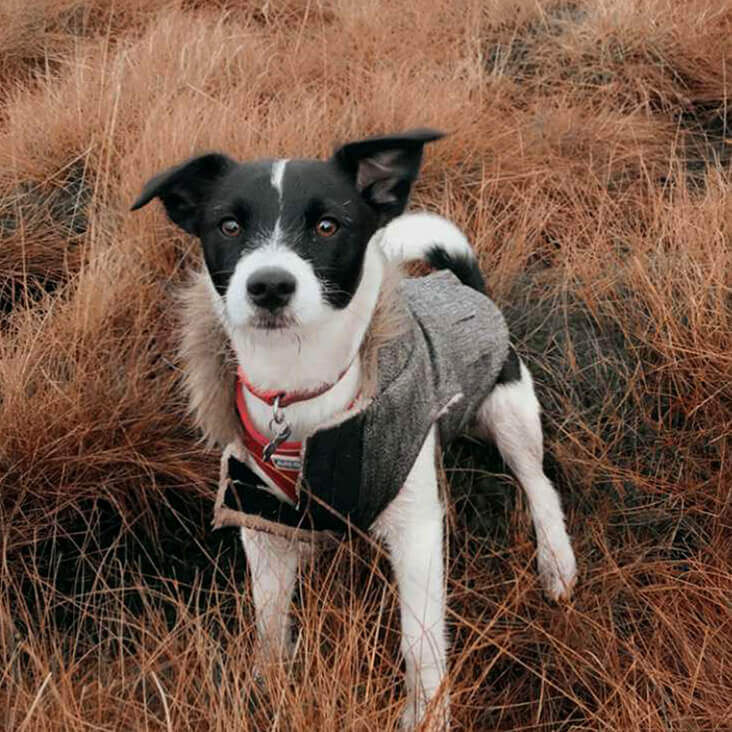
Training Your Dog To Wear A New Coat
If your dog hasn’t worn a coat before, they might be fearful of having it put on. This is why it’s important to introduce it slowly like with any other new object.
If your dog has worn a harness before, this might be easier.
But if you’re starting from scratch, follow our handy tips for getting your dog comfortable in no time…
Step One
Lay the coat on the ground, and sprinkle it with some of your dog’s favourite treats.
Your dog should start to investigate the coat, and hopefully eat the treats from it. This will give your dog the idea that positive things happen around the coat.
Step Two
Once your dog is familiar with the coat, lift it up and feed them a treat through the opening.
Gradually move your hand further back to encourage your dog to push their mouth and nose through the opening to get their treats.
Step Three
Once your dog is comfortable putting their nose and mouth into the coat, you can try to place it on their body.
Keep giving them treats for positive reinforcement.
If they dislike the coat, or become uncomfortable, take a step back and try again later. Give them some more treats to show them that this is a positive experience.
The key is slow but steady using positive reinforcement.
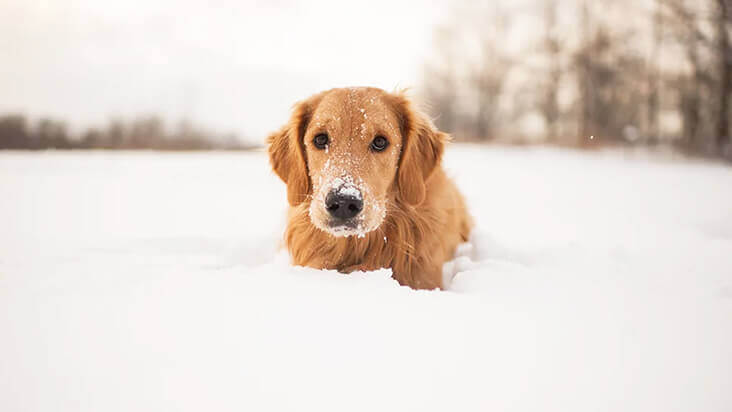
Tips For Winter Walks With Your Dog
Once you’re both in your winter gear, you’re probably ready to head out for a walk.
Dogs can find snow unusually exciting, especially if they haven’t experienced it before. And even if they have, in most places around the UK it will have been a long time since they last saw it.
That’s why it’s important to keep them safe outdoors in winter weather. Because there are hazards that come along with the snow and ice.
Keeping Your Dog On The Lead
If you’re heading out for a walk in heavy snow, it’s usually best to keep your dog on the lead. Even if they usually explore freely on walks, it might be harder to see clearly for both of you. The last thing you want is to lose each other.
You should also make sure that they’re wearing their collar and ID tags – just in case something does happen to them when out and about. In the cold weather, being found and reunited quickly is the most important thing.
Keeping Yourselves Visible
This is important for both you and your dog. That’s because in heavy snow, it can be hard to see clearly.
Make sure you wear high visibility clothing and that your dog is visible too. Some pet shops sell flashing or reflective collars that help your dog be seen in bad weather.
Avoiding Grit and Ice
Grit used to melt ice and snow on roads and pavements can be an irritant to your dogs paws and skin.
If you find that your dog is particularly sensitive to this (or your usual route is through areas that will be gritted) you can buy special boots designed to protect your dog’s paws. These can be picked up at a variety of pet outlets. They might not be quite as stylish as some of the human wellingtons on offer, but they do the trick.
Ice itself can also present a hazard. If you think of how difficult it is for you to walk along an icy stretch of path – just imagine how much harder it would be with 4 legs! Where you can, plan in advance to avoid the iciest parts of your walk.
After your walk, make sure to wash down your dog’s legs, stomach and paws with warm water and dry them well. This will remove any irritants or dampness from outdoors. Check in between their toes for any grit, snow or ice that has gotten stuck.
Staying Away From Frozen Ponds
Here in the UK, it just doesn’t get cold enough for lakes and ponds to freeze deeply. Even if a body of water looks frozen, it might only be a thin layer of ice.
For this reason, keep your dog away from the water’s edge in winter. The ice might not be enough to take their weight and could crack underneath them.
If your dog does fall through ice, don’t go in after them. Try to encourage them to swim back to you and go for help as soon as possible.
Winter Hazards To Watch Out For
As with all types of extreme weather, winter comes with its own hazards to keep an eye on.
We’ve listed some of the most common below, along with advice about how to help avoid them…
Grit
As mentioned above, grit used on roads can irritate your dog’s paws. If you walk along gritted paths, buying them special booties might be the best option.
And once you get home from your walk, make sure to wipe down your dog’s paws and check in between their toes for any debris.
Antifreeze
Many dogs find antifreeze very tasty – but it is highly poisonous to them. That’s why it’s important to keep it out of their reach and in a secure bottle.
Cold Cars
In summer, you often see warnings not to leave your dog alone in a hot car. And the same applies to cold cars in winter. Your dog needs to stay warm, and a car covered in ice isn’t a good place for them to be left.
Litter
When everything is covered in a blanket of snow, things usually noticeable can get hidden – like rubbish and other litter.
Your dog will be able to spot this more easily than you.
Make sure you see that they’re digging around in something they shouldn’t be.
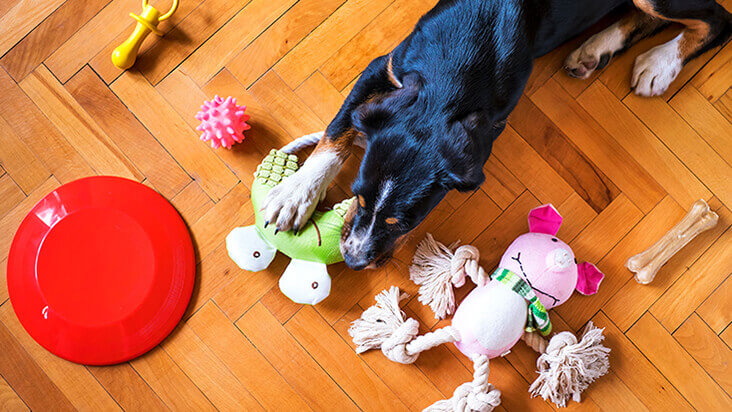
Keeping Your Dog Active
When it goes dark early, it can be hard to get out for your usual long dog walk.
If you manage to get out for a short walk, try and vary the route each time so your dog can experience new sights and smells.
In the dark evenings, stick to well lit streets and places that you know well. Always keep your dog on a lead in the dark.
Sometimes, even in daylight, the winter weather might be too bad for you to think about venturing out.
In this situation, it’s important to make sure your dog gets plenty of stimulation and exercise indoors.
The key is to be inventive.
Many games can be played in even small homes. One example puzzle feeder toys or kongs, which you can stuff with your dog’s favourite treat.
Or you could put in some training ours and teach some fun tricks you might not usually have time to focus on.
If you want some indoor inspiration, we created a post with lots more tips and tricks about it here.
Our Final Tips…
Snow and winter weather can be fun for dogs and humans alike…
But it’s important to keep your furry friend safe and healthy throughout winter.
By keeping them warm and avoiding the hazards that can come along with the colder weather, you can keep your dog happy and take them out to safely enjoy the snow.
The crucial thing is to stay listen to your dog’s needs as they know what they need better than most.
References
https://www.battersea.org.uk/pet-advice/dog-care-advice/winter-dog-care
https://www.dogstrust.org.uk/help-advice/dog-care/cold-weather-advice
https://www.bluecross.org.uk/pet-advice/looking-after-your-dog-winter-0
https://julius-k9.co.uk/blog/keeping-your-dog-active-and-entertained-in-coronavrius-lockdown

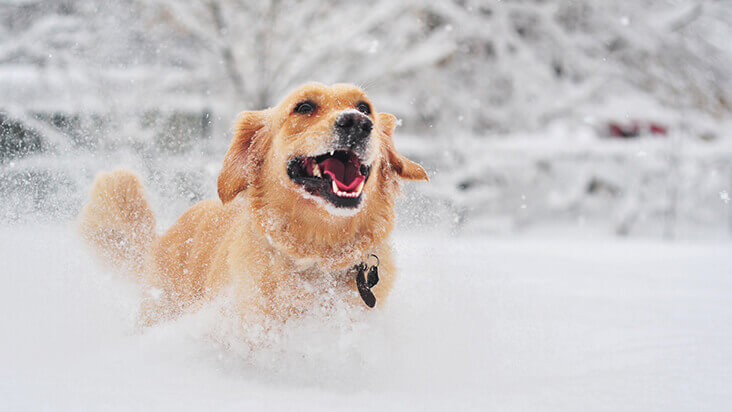




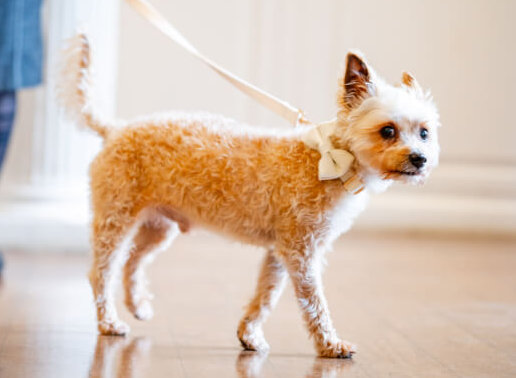
Comments